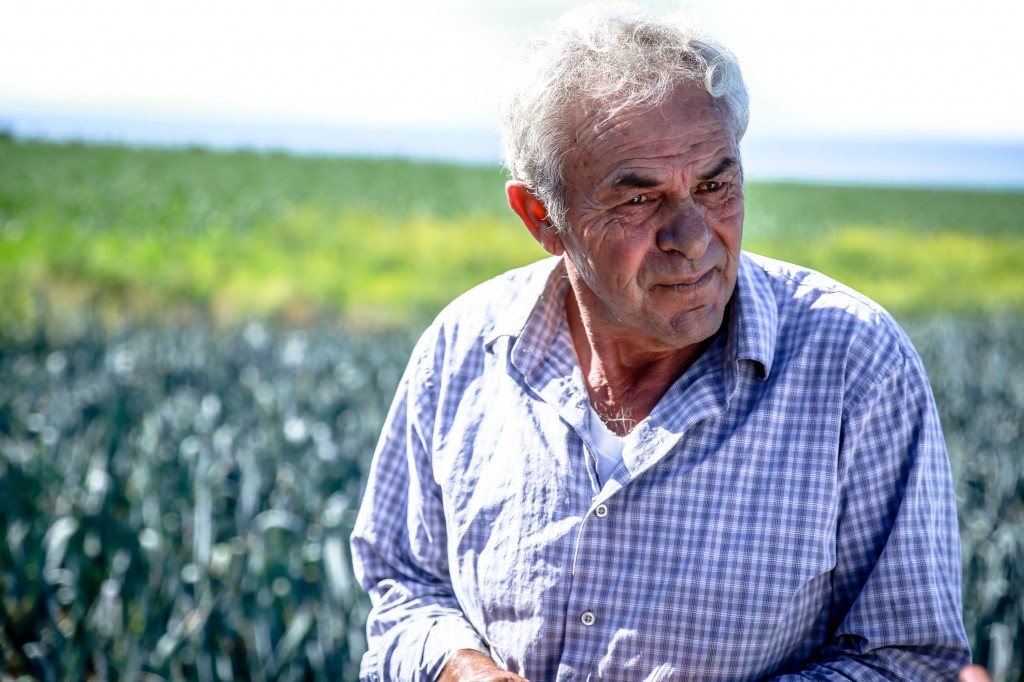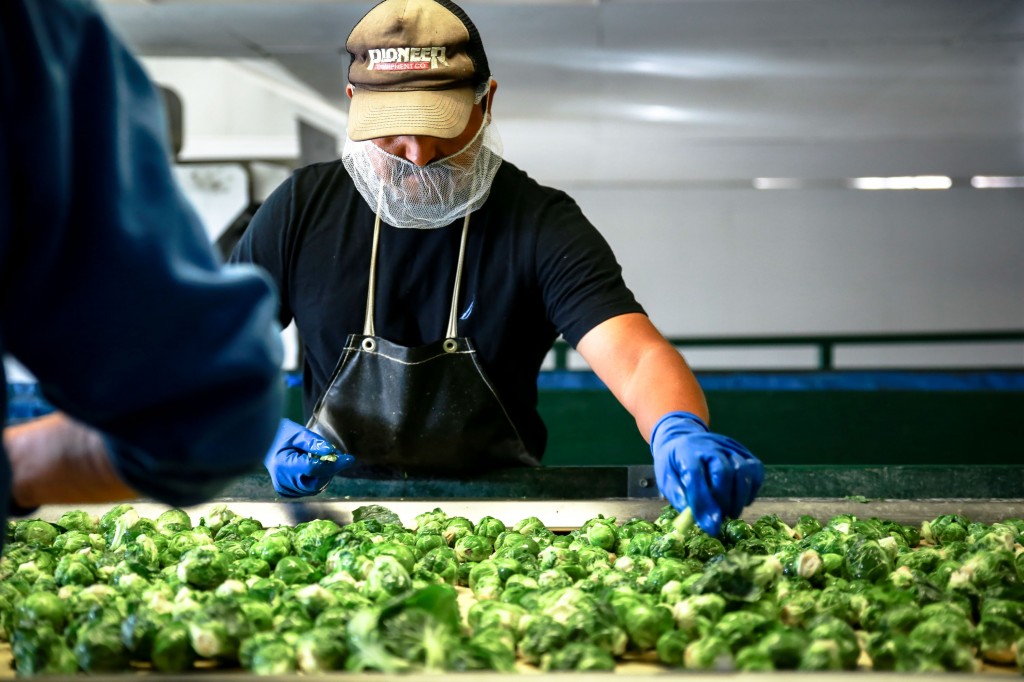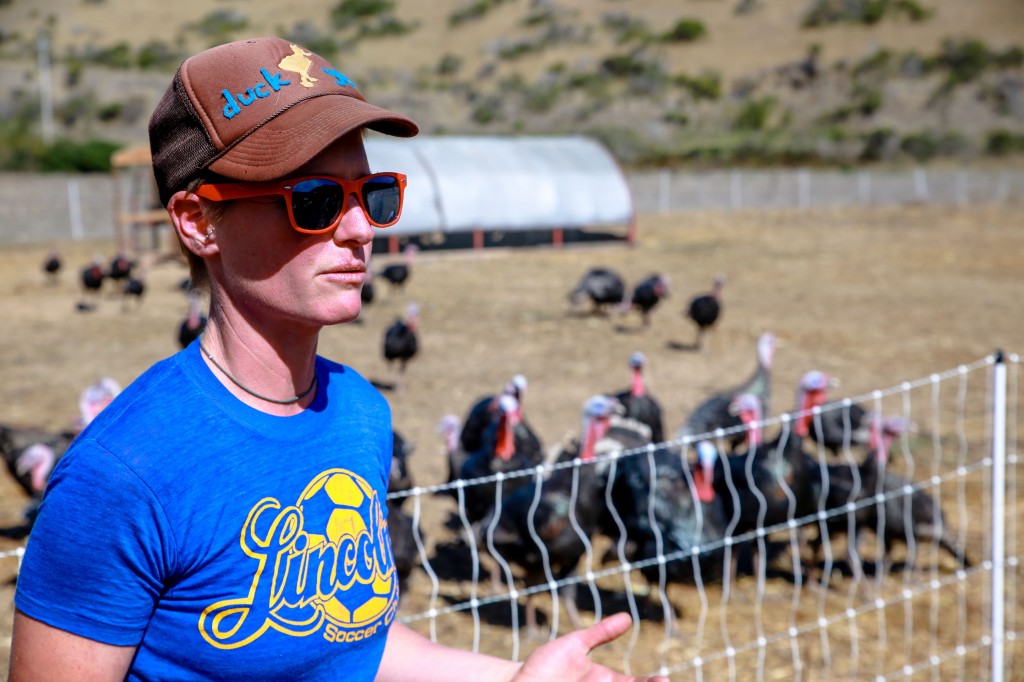
Joe Muzzi stands between rows of Brussels sprouts, his legs hidden from the waist down in the lush growth, and scans the 350 acres of his farm that extend down the Pescadero coastline. He lifts the heavy leaves of one of his plants and reveals the bulbous, green bundles that will be hand picked and shipped off to grocery stores around the country in the coming weeks. They will be sold for around $2 a pound nationwide, a small fraction of which he will receive after the costly storage and shipping process.
Next season, he worries, will likely be a much grimmer story. Brussels sprouts might cost as much as $6 a pound at your local grocer, he says, and that might seem like good news for local producers like Muzzi. But if prices spike that high it will be costly imports in the stores, not California-grown Brussels sprouts. Instead, Muzzi will probably be out of business, and these now bountiful fields will hold only dry soil.
“It all depends on what happens next year,” he said in reference to the ongoing drought. For the past three years, California has experienced record lows of rainfall. Across the state, rivers and creeks have run dry and lakes bear broad, white borders of dust where water levels once reached. In some places the ground has literally lost elevation as the water tables beneath them are drained away by agriculture and increasingly thirstier towns, while the ordinarily replenishing seasonal rains simply can’t keep up. Some scientists claim this is the worst drought we have seen in 500 years, and worse yet the U.S. Environmental Protection Agency (EPA) asserts that it is possibly part of a permanently changing climate: an EPA report from last September states that in the Southwest: “Average annual temperature is projected to rise an additional 2.5 to 8 degrees Fahrenheit by the end of the century.” The climate is certainly part of the problem, but many farmers also blame the sharp drop-off in water projects throughout the state, as well.
“We’ve survived so far,” Muzzi said. “But we don’t have a drop of water for the coming year. If it doesn’t rain this winter we are out of business.”

“He will not be alone,” said Jay Lund, the director of the Center of Watershed Sciences at UC Davis. A recent UC Davis report states that the current state water shortage will result in a direct loss of $1.5 billion to California’s agricultural economy, and when factored in with the estimated 17,100 jobs lost in association with the drought, that number reaches $2.2 billion.
“Next year the groundwater levels will be lower,” Lund said. “More of the wells farmers depend on will be stranded unless there is a lot of rain, and the reservoir levels are already lower so it’s going to be harder to get full [water] deliveries next year than this year.”
Muzzi comes from a family of farmers. His father and uncle grew Brussels sprouts in these same fields, and his sons and grandson work with him now. Unlike farmers in other parts of California who rely on wells that tap into groundwater, many Pescadero farmers use large holding ponds to trap rainwater when it falls. Muzzi’s crops depend on water from ponds built in the 1930s. The ponds can store up to 1,000 acre-feet of water (imagine an acre of land with 1,000 feet of water on it – it’s a lot of water), and every winter they build up the water reserves that irrigate the crops during the rest of the year.
However, the disastrously low rainfall of the last few winters has left the ponds empty. But farms don’t survive for generations in California without backup plans. Luckily, even this exceptional drought is something that Muzzi has prepared for.
During a three-year dry spell in the 1970’s, Muzzi and his uncle undertook planning and building a network of emergency ponds as an insurance plan to cope with any future droughts. With the help of the San Mateo Resource Conservation District (RCD), they built emergency holding ponds in a cool nearby canyon that hold 20 acre-feet, which is enough to irrigate 20-25 acres of Brussels sprouts throughout the season. It’s not much, but that extra water was enough to keep Muzzi’s crop – and his farm – alive through the past summer.
“Within 60 days [of planning the emergency ponds] we had begun the project, and within 120 days the ponds were built,” Muzzi recalled.
That kind of rapid response is unheard of today, with an abundance of regulations and restrictions surrounding any kind of water development.
“The other day I went to the same agency to talk about enlarging the ponds or maybe building some new ones,” Muzzi said. “They told me that if there are no endangered species there we can build some in two, maybe three years. Farmers can’t work with that, we need the water now. It’s an emergency, we need to act.”

Even building new ponds today would likely be too little, too late. Muzzi’s problems are representative of a general insufficiency of agricultural water reservoirs across the state. Major water projects for agriculture are no longer a state priority, nor have they been for the past 30 years. A timeline of California water development history clearly demonstrates the problem: before 1980, dams and reservoirs dominated water-related policy decisions. However, in the last 30 years, no major reservoirs have been constructed for agricultural purposes, despite the intensifying danger of dry weather as climate change impacts water throughout the state.
Other farmers are taking different approaches in the area. A 15-minute drive from Muzzi’s large-scale conventional farm, Dede Boies, a young organic farmer, has begun her first operation, Root Down Farm, with just one other partner. However, instead of growing crops, she has elected to start with livestock, a choice heavily influenced by the drought. Boies’s farm uses water from a nearby creek, which is now producing little more than a trickle. Because livestock uses significantly less water than crops, starting with pigs, turkeys and chickens removes some of the risk from the equation.
“We are really limited by water and this drought was a huge factor in that decision,” Boies said. “We didn’t want to be too dependent on water. If water was not an issue, we would definitely be introducing a lot more perennials.”
However, Boies views this drought not as an isolated incident but as one of the many inherent risks associated with farming in California.
“Sure, this is a drought year, but things are changing and it’s not just a one-year thing; there is definitely a bigger problem that we need to work with,” she said. “We can’t just put a Band-Aid on it for a year. We need to have systems in place.”
This is a perspective that Boies shares with Jay Lund. “California is a dry state, we have droughts,” he said. “We are going to have some bad times. That ought to be part of people’s business plans.”
Boies is building the foundation of her farming operation from the ground up, beginning during a drought year and introducing only what she can sustain on a limited water supply. Creating a water system that is designed to survive intensifying water shortages and a new, drier climate is going to be easier for her than for others.
Muzzi on the other hand is left with a system built for a far wetter California than the one that climate scientists conclude will be the new norm. And he’s not sure if there’s anything he can do now to keep his fields green. “I feel the government is doing nothing to help us,” Muzzi laments. “If they really wanted to help us they would say, ‘let’s start building ponds next week.’ If we had storage ponds and dams throughout the state, we would not be in this predicament.” For farmers like Muzzi — who acted early and responsibly to prepare for California’s old droughts, but not for a new, much drier future — there is now nothing left to do but wait, and hope for rain.
